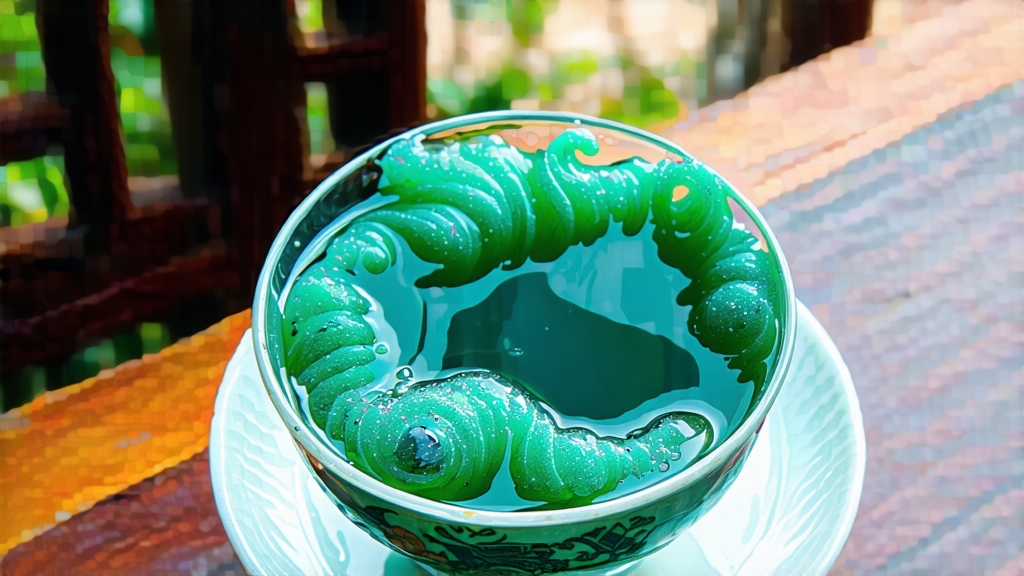
Biluochun, whose name translates literally to “Green Snail Spring,” is one of China’s ten most celebrated teas, yet it remains a quiet legend outside Asia. Produced only in a narrow micro-zone around Dongting Mountain in Lake Tai, Jiangsu Province, this tea turns the idea of “terroir” into liquid poetry. Its minute, spiral-shaped leaves smell so intensely of white peach and alpine orchid that when it first reached the imperial court in 1699 the Kangxi Emperor is said to have renamed it “Green of Spring Snail” because its curls resembled tiny jade snails and its fragrance rivaled the season itself.
History and Myth
Local growers still recount two founding myths. The first speaks of a tea picker who hid fresh leaves in her bosom to keep them from bandits; body heat lightly oxidized the buds, releasing an unprecedented perfume. The second tells of wild tea trees growing among peach, plum, and apricot groves on Dongting’s mist-shrouded peaks; cross-pollination infused the leaf with fruit-blossom aromatics. Whatever the truth, written records from the Ming dynasty (1368-1644) already list “Xia Sha Ren Xiang” (literally “Astounding Fragrance”) as a tribute tea; the name Biluochun was formalized two centuries later.
Micro-Terroir
Dongting Mountain is actually two islands—East and West Dongting—rising from a shallow, mineral-rich lake. The water moderates temperature, creating constant evaporation that blankets the slopes in fog. This natural shade forces the tea bush to produce more chlorophyll and theanine, yielding leaves that are jade-green, needle-thin, and impossibly tender. Only 12 square kilometers of certified gardens exist, and the best plots sit between 200 and 300 m on south-facing terraces of weathered granite. Soil pH hovers at 4.5–5.5, ideal for Camellia sinensis var. sinensis bushes cloned from centuries-old mother plants.
Varieties Within a Variety
Purists recognize three descending grades, all harvested within a frantic 20-day window starting around Grain Rain (April 20).
- Mingqian Biluochun—picked before Qingming (5 April) when nights are still cool. One kilo requires 140,000 buds, each the unopened standard of one leaf and a half-millimeter stem.
- Yuqian Biluochun—picked before Grain Rain. Slightly larger leaves, yet still downy and curled by hand into spirals no bigger than a paperclip.
- Chunwei Biluochun—late spring leaf. Still fragrant, but the cup is lighter and the price drops exponentially.
Crafting the Spiral
The entire process must finish within 24 hours of picking.
- Withering: Buds are spread on bamboo trays for 2–4 hours in shaded draft; lake breeze reduces moisture to 68 %.
- Fixing: Woks are heated to 180 °C, then cooled to 120 °C within seconds. A master “tea killer” tosses 250 g of leaves for 3–4 minutes, using wrist flicks that imitate calligraphy strokes. Enzymes are denatured while peach-like aromatics are locked in.
- Rolling: While still warm, leaves are rolled against the wok’s rim in a counter-clockwise motion. Pressure starts light, then tightens until each bud forms a spiral with hidden down. A veteran can shape 1 kg per hour; an apprentice manages half that.
- Final firing: Temperature drops to 70 °C for 15 minutes to reduce moisture to 5 %. The finished tea weighs only one-fourth of its fresh weight.
Chemical Signature
Gas chromatography reveals 42 volatile compounds, dominated by linalool (floral), geraniol (rose), and trans-β-ionone (peach). The amino-acid-to-polyphenol ratio exceeds 0.3, explaining the tea’s famed umami sweetness and absence of bitterness when brewed correctly.
Brewing Ritual for the International Table
Western scales and metrics often fail Biluochun; its downy hairs clog infusers and its perfume evaporates at boiling point. Use a 200 ml borosilicate glass or gaiwan to watch the “three-stage dance.”
- Water: Filtered, low mineral, 75 °C. Boiling water scalds; 80 °C dulls.
- Dose